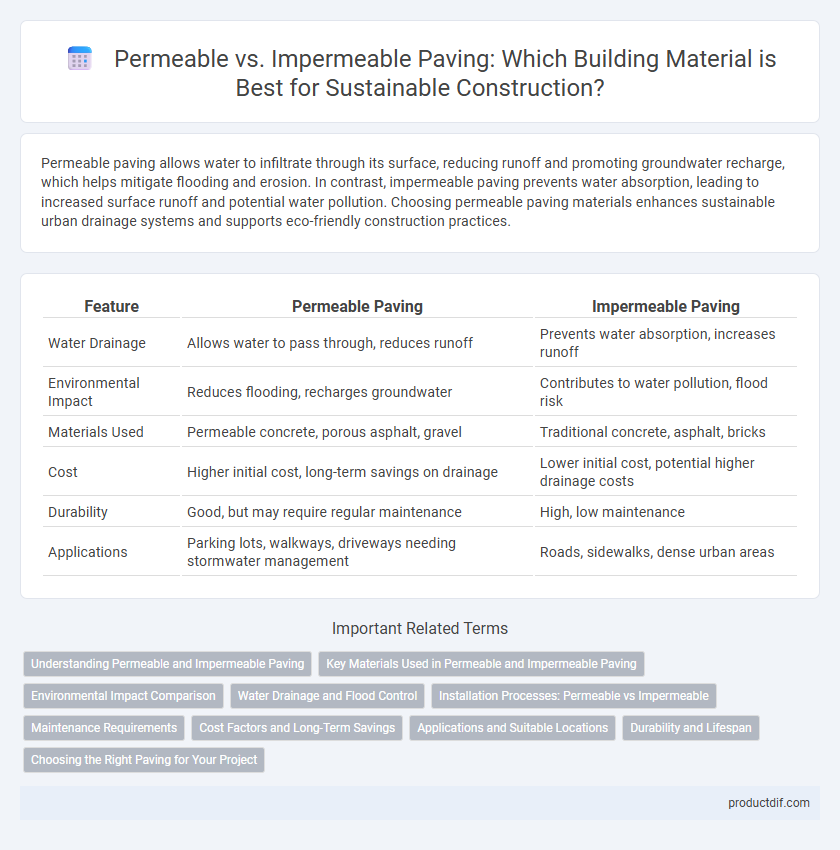Permeable paving allows water to infiltrate through its surface, reducing runoff and promoting groundwater recharge, which helps mitigate flooding and erosion. In contrast, impermeable paving prevents water absorption, leading to increased surface runoff and potential water pollution. Choosing permeable paving materials enhances sustainable urban drainage systems and supports eco-friendly construction practices.
Table of Comparison
| Feature | Permeable Paving | Impermeable Paving |
|---|---|---|
| Water Drainage | Allows water to pass through, reduces runoff | Prevents water absorption, increases runoff |
| Environmental Impact | Reduces flooding, recharges groundwater | Contributes to water pollution, flood risk |
| Materials Used | Permeable concrete, porous asphalt, gravel | Traditional concrete, asphalt, bricks |
| Cost | Higher initial cost, long-term savings on drainage | Lower initial cost, potential higher drainage costs |
| Durability | Good, but may require regular maintenance | High, low maintenance |
| Applications | Parking lots, walkways, driveways needing stormwater management | Roads, sidewalks, dense urban areas |
Understanding Permeable and Impermeable Paving
Permeable paving materials, such as porous asphalt, pervious concrete, and interlocking pavers, allow water to infiltrate the surface, reducing runoff and promoting groundwater recharge. Impermeable paving, including traditional concrete and asphalt, prevents water penetration, leading to increased surface runoff and potential drainage issues. Selecting permeable paving supports sustainable stormwater management and mitigates urban heat island effects in built environments.
Key Materials Used in Permeable and Impermeable Paving
Permeable paving primarily uses porous materials such as permeable concrete, porous asphalt, and interlocking pavers with open joints to allow water infiltration and reduce runoff. Impermeable paving commonly relies on dense materials like traditional concrete, asphalt, and sealed surfaces that prevent water absorption and increase surface runoff. The choice between these materials significantly impacts stormwater management and urban heat island mitigation.
Environmental Impact Comparison
Permeable paving significantly reduces stormwater runoff by allowing water to infiltrate the ground, thereby decreasing soil erosion and mitigating flooding risks. In contrast, impermeable paving increases surface runoff, contributing to water pollution and overwhelming drainage systems. The environmental benefits of permeable paving include improved groundwater recharge and enhanced urban heat island mitigation.
Water Drainage and Flood Control
Permeable paving systems enhance water drainage by allowing rainwater to pass through the surface and infiltrate the soil, significantly reducing surface runoff and mitigating flood risks. In contrast, impermeable paving prevents water infiltration, causing increased runoff that can overwhelm drainage systems and heighten flood potential. Utilizing permeable materials such as porous asphalt, permeable concrete, and interlocking pavers improves stormwater management and supports sustainable urban drainage solutions.
Installation Processes: Permeable vs Impermeable
Permeable paving requires careful installation of a layered system including a geotextile fabric, crushed stone base, and permeable surface materials to ensure water infiltration and structural stability. Impermeable paving involves compacting a solid base and applying dense, impermeable materials such as asphalt or concrete, designed to prevent water penetration and facilitate runoff. Proper installation of permeable systems demands precision in layering and grading to maximize drainage, while impermeable paving prioritizes smooth, sealed surfaces for durability and ease of maintenance.
Maintenance Requirements
Permeable paving requires regular cleaning to prevent clogging from debris and sediment, ensuring effective water infiltration and drainage. Impermeable paving demands less frequent cleaning but often needs maintenance for cracks and surface wear to prevent water pooling and damage. Choosing permeable systems can reduce stormwater management costs but may increase labor for routine upkeep compared to impermeable options.
Cost Factors and Long-Term Savings
Permeable paving typically incurs higher initial costs due to specialized materials and installation techniques compared to impermeable paving. However, permeable systems reduce expenses related to stormwater management, erosion control, and municipal fees, resulting in significant long-term savings. Impermeable paving often leads to additional costs from drainage infrastructure and potential regulatory fines, making permeable options more cost-effective over time.
Applications and Suitable Locations
Permeable paving is ideal for areas requiring effective stormwater management, such as parking lots, walkways, and residential driveways, allowing water to infiltrate and reduce runoff. Impermeable paving suits high-traffic urban roads, commercial plazas, and industrial sites where durability and low maintenance are critical, but drainage systems must be externally managed. Selecting permeable or impermeable options depends on local climate, soil conditions, and regulatory requirements for water management.
Durability and Lifespan
Permeable paving offers enhanced durability by reducing surface water retention, which minimizes freeze-thaw damage and extends lifespan up to 30 years when properly maintained. Impermeable paving, typically made from concrete or asphalt, can last between 15 to 25 years but often suffers from cracking and potholes due to water buildup and poor drainage. Choosing permeable materials supports longer-lasting pavements with reduced maintenance costs in regions prone to heavy rainfall.
Choosing the Right Paving for Your Project
Permeable paving allows water to infiltrate through the surface, reducing runoff and promoting groundwater recharge, making it ideal for environmentally conscious projects and areas with strict stormwater management regulations. Impermeable paving, such as traditional asphalt or concrete, provides durable, load-bearing surfaces suited for high-traffic zones but requires effective drainage systems to manage water accumulation. Selecting the right paving depends on factors like project location, environmental impact goals, load requirements, and local climate conditions.
Permeable paving vs Impermeable paving Infographic

 productdif.com
productdif.com